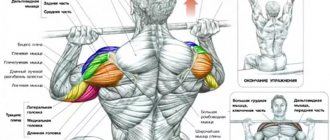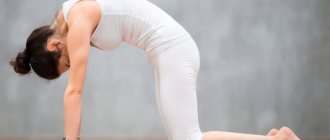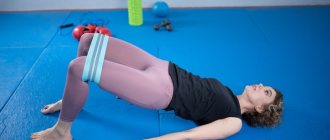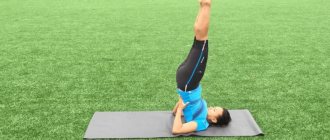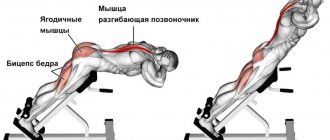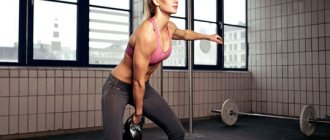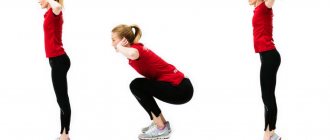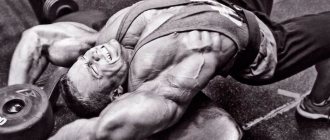Rope exercises are excellent for developing the muscles of the upper body. Complex development of the spinal muscles is carried out by using the latissimus, rhomboid and trapezius muscles. But to develop muscles, you need to know how to climb and descend a rope correctly, so as not to injure yourself and perform the exercise as quickly as possible. Proper technique not only increases muscle strength, but also improves dexterity and coordination.
Benefits of rope climbing
Rope climbing is a basic exercise for developing mental strength and strengthening all the muscles of the body. The exercise puts maximum stress on the athlete's upper body.
If you use both arms and legs, then all the muscles of the body will work. Over time, rope crawling becomes easier and easier, and it can become part of a regular workout to work out the relief of the body.
What muscles work
In the process of rope climbing, the back muscles are perfectly worked out. The shoulder girdle and cervical vertebrae are involved. When a person gains the skill of lifting up without using his legs, the biceps brachii muscle will be worked.
The main load goes on the back, shoulders and arms.
The biceps are also stressed. Each hand is used in turn in this process. This increases the load on the biceps many times over. The effort of one hand lifts the weight of the entire body. This allows the torso muscles to be pumped and tensed evenly.
Cable exercises, especially without the use of legs, are excellent for working the latissimus, rhomboid and trapezius muscles of the back, rear deltoids, biceps and forearms. Strength endurance is developed and grip strength increases. The neck and abdominal muscles are subjected to excellent stress. Improves coordination and agility.
Small stabilizer muscles, which are difficult to use in the gym, are perfectly developed by regularly going up and down the rope.
Effect on general physical condition
Climbing up a rope is very useful for an athlete - this exercise increases endurance and increases grip strength. Increases dexterity and develops coordination. General physical condition improves. Strength and self-confidence appear. Constant training builds endurance and resilience.
Blood circulates better and the immune system is strengthened.
Preparing for rope training
For beginners, doing even a small set of exercises is problematic. Adequate training is required to ensure you have enough strength to ascend and descend the rope. Even experienced athletes should start with basic exercises.
To understand how to climb a rope correctly and effortlessly, you need to develop physical endurance and become familiar with the three rope climbing techniques.
General complex for the development of core muscles
The legs, arms and back are exposed to physical stress. For beginners, it is best to use a separate small rope or a gymnastic stick. You can check your flexibility and readiness for exercise by wrapping your arms and legs around the rope and moving it up and down along a trajectory that you can master.
Hand grip exercise
The hands are pressed tightly against the support and fixed. You need to check the endurance and strength of the upper muscles. The main load falls on the forearm and hands. As they develop, the arms become stronger and are able to withstand even greater loads.
Hold yourself on your hands until you feel slight fatigue in your muscles. After this, begin to slowly lift up until you need help from your legs. As soon as your strength is gone, you can use your legs to work.
Exercises to develop leg muscles
To develop leg muscles, first sit on a bench or chair. Take a stick for training the feet, and apply it to the outside of the right leg so that the left heel presses on top and fixes it, resting it on the toe. The hips and feet are actively involved. The harder you squeeze, the more effective the result will be.
The grip with your legs should be strong enough to keep you on the rope.
As you train your endurance, you need to try to additionally drag the stick up. If you can pull out the stick without much difficulty, then the clamp is weak and needs to be strengthened.
Keep practicing until you feel a lot of resistance when trying to pull out the “rope”.
What types of ropes are there?
Ropes differ in fiber material and thickness. Like sailor's ladders, ropes have their roots in ship's rigging, where they were made from hemp. Hemp rope is rigid, but does not slip and is quite grippy. If a child is just learning to climb a rope, it is better to take a less rigid, cotton or synthetic rope. Thin ropes 16-20 mm are good for tying in knots . Synthetic ropes can be used for these purposes Thin synthetic ropes are good because they are durable when used both at home and outdoors. Thick cotton ropes , 30-40 mm thick, do not need to be tied with a large number of knots (it will be difficult for a child to climb through such knots), it is better to leave them loose, with a loop or only one knot at the bottom. Thick cotton ropes without knots are best suited for learning to climb, and it is better to start with a thick cotton rope (40 mm), as opposed to bars and poles (which should be 28-32 mm), a thick rope (40 mm) is more grippy and stable, perhaps because in this case it is easier to grasp it not only with your hands, but also with your legs. At home, cotton rope will last almost forever. But on the street, it quickly wears out at the fastening points and loses its appearance. When used outdoors, it is advisable to change the cotton rope once a season or remove it, check the fastenings and wash it. Thick synthetic ropes, which manufacturers of outdoor playgrounds like to use, have little functionality: they are too rigid, not flexible, and rub children’s hands. Children avoid using them.
In general, about rope climbing techniques
There are many types of exercises like rope climbing. Each type has its own characteristics. Depending on your physical fitness, you can choose the most suitable exercise. First, the arm muscles are worked out, since the emphasis is on the upper limbs. The legs play the role of support. Developed calves and buttocks help you make clear and confident movements.
We must not forget about the mobility of the shoulder and cervical spine. For a good workout of all muscle groups, key sections must be developed as much as possible. The development of endurance and stamina when performing complex physical exercises depends on their development.
Rope tied in a wide loop on a beam
A third option to encourage the use of a swing rope is to tie it in a wide loop between two points on the beam. We sometimes recommend doing this in large complexes: the rope is not at all elastic and gives a completely different effect than a vine.
But sometimes children experiment with the rope themselves, tying it to something conditionally static (for example, to Skripalev’s ladder). Then the attraction begins, depending on the age of the child, which has different difficulties: reach a rope from somewhere nearby, try to jump and hang on it, sit on the rope (which is not very convenient) and swing on it, or, using the loop as an intermediate point, dynamic mode to move through it from projectile to projectile. We, as parents, checking the reliability of the knot that the children tried to tie and tightening it if necessary, do not deny children such experiments. All this is included in the endless range of games on the complex, which both develop and entertain the children climbing on the complex.
Rope Climbing Methods
There are three fundamental methods of rope climbing, which, when mastered, can be used to perform more complex exercises. This base helps develop muscle groups and improve endurance. Let's consider these methods in detail.
In three steps
The three-step method is a classic basic exercise that helps develop stamina and confidence. This method is used to learn rope handling techniques from scratch.
To perform the technique in three steps, follow the instructions:
- They stand next to the rope and clasp it tightly with their hands. At the same time, the arms are raised slightly above the head, and the neck is stretched upward.
- The legs are bent and pulled higher, wrapping them around the rope: it is held between the heel of one leg and the toe of the other.
- The legs are straightened and at the same time pulled up on the arms.
- Hands alternately move slightly above the head. In this case, you need to hold on to the rope with your feet.
- Repeat the exercise, starting from the second point, until the top of the rope is reached.
In two steps
The method is energy-consuming and requires basic physical training. When the desired results are achieved, a high speed is developed when lifting. Exercise plan:
- Stand on the ground next to the rope.
- Stretch one arm up and hold the rope just above your head.
- Second, grab the rope at chest level.
- Holding firmly with your hands, pull your legs up and squeeze the rope between the heel of one and the toe of the other.
- Straighten your legs and move your lower arm higher, above your head.
- Repeat the movements.
Without the help of legs
Quite a difficult exercise for a beginner. Before attempting it, make sure you have sufficient upper limb strength and endurance to handle it. Start the exercise after mastering the two previous elements. If you feel like you can't cope, use your legs.
The technique is as follows:
- Stand next to the rope and clasp your hands around it: one slightly higher than the other.
- Bend your legs slightly, but do not wrap them around the rope. You need to hang only using the strength of your arms.
- Pull yourself up using your arms, alternately moving your arms higher and higher. You need to move only using the strength of your muscles and shoulder girdle.
Rope as a hole in a tree
An example of an indispensable place for a rope would be the use of a rope as a climb to a tree. If you hang a rope of suitable length on a strong branch perpendicular to the trunk next to the trunk, then children quickly realize that they can climb into the fork of the tree by holding the rope with their hands and moving their feet along the trunk .
In this country sports complex, conveniently located on an old and strong walnut tree, the rope plays one of the most important roles.
A pair of equipment for older children is a liana. If you hang it near a fork between widely spaced strong branches, then it becomes a way to jump from a tree (the child jumps on the vine, swings up and down on it several times, then gets off or jumps to the ground). But that's another story. At a home gym, you can try hanging a rope in the immediate vicinity of the climbing wall to encourage the child to try to combine these two apparatuses in lasagna.
Safety precautions
Rope climbing must take place in compliance with certain safety precautions. The traumatism of the ascent and descent technique is quite high. It is important to understand that before exercise you need to warm up your muscles. Instructors always read parting words before training. When exercising in the gym on your own, you will have to remind yourself of the main rules for performing the exercise and be sure to follow them.
When climbing a rope
You can perform this exercise only after warming up and warming up. The athlete must be in good shape, with developed arm and back muscles, since it will be very difficult to learn how to climb a rope without the necessary physical characteristics. At a minimum, you should have enough strength to do 10 pull-ups or push-ups.
Conduct your first training sessions in the gym with mats underneath.
And now the rules themselves:
- The emphasis always lies first on the hands. When lifting, they should be secured comfortably and tightly.
- One hand, no matter what, always clasps the rope above the head. It is straightened as much as possible in order to tighten the torso.
- The second fixes the position of the body and helps to move strictly in the horizontal direction.
- The top hand cannot be weakened.
In some cases, it is possible to give relief to the leading hand, but in this case it is impossible to move. We stop and relax all the muscles as much as possible.
When descending
Going down is much more difficult than going up. During the ascent, a lot of effort is expended. When descending, the muscles are quite tense; slight fatigue is present in them in any case. Again, the emphasis is on the leading hand. The legs fix the position during the descent and control the speed of movement.
- You cannot tilt your head down.
- You need to grab the rope tightly and firmly.
- The body is in a straight position, starting from the starting position and ending with the feet touching the ground.
- Under no circumstances should you slip off the rope.
- The movements are carried out strictly in the same order as when lifting: arms and legs move alternately, but down the rope. There are even more stringent rules: you need to move slowly and in a spaced manner.
Pay attention to your breathing and the sensations in your body.
Conclusion
The vertical rope climbing exercise is interesting not only for CrossFitters. It effectively develops core, strength, endurance and grip strength. There is a reason why this exercise is used by the military, special forces and firefighters. If you have the opportunity to implement an exercise into your training, then you should not neglect it. By the way, the exercise can be complicated if you use weights when lifting. Of course, this embodiment should be treated with the utmost caution and the weight should be increased gradually. Always monitor how you feel and refuse the exercise at the slightest discomfort.
And also read: CrossFit training for beginners →
Common mistakes made by newbies
When performing both complex and easy exercises, typical mistakes can occur. They should not be allowed, since the final result depends on the correct implementation of this or that complex.
Incorrect placement of arms or legs
Hands and feet must be clearly fixed on the support. You cannot spread your elbows, otherwise the entire load will be distributed on your back. The shoulder joints may become sore and the spine may be injured.
The legs should provide good grip. With their help, it is possible to relieve the load on the upper part of the spine and distribute the force evenly across all muscles. Do not ease the load on your legs.
Using gloves
Beginners think that gloves will help strengthen their grip and protect against calluses. But this is a wrong belief.
No need to use gloves.
They will not protect you from injury, but on the contrary, they will weaken your grip and increase the risk of slipping. Gloves are often the cause of injuries on the rope. Descending with personal protective equipment is contraindicated.
Low hand grip
Hands should be placed as high as possible above head level. Capture is carried out along the entire accessible trajectory.
A low grip will increase the load.
If you position your hands incorrectly, the load on them will increase. This will require additional effort. Shoulders and hands get tired quickly. The rate of ascent decreases.
Wrong descent
Both experienced athletes and beginners must take into account the fact that injuries can largely be avoided if safety precautions are followed. The most important point that is discussed by trainers before classes is the issue of the correct descent from the rope.
Important ! You must not jump or slide off the rope. These methods can cause serious injuries and burns to the palms.
Summary
Whether the rope will be used and loved by a child depends on several parameters. Firstly, the material from which the rope is made. On street playgrounds in our country, you will mostly find hard synthetic ropes; they are not very pleasant to the hands and are not very grippy (slip). Children do not like such ropes and this stops many adults from experimenting with this, in general, wonderful apparatus. Since the apparatus is complex (requires mastery), its place in the sports complex should initially be indispensable. That is, it should be included in some route where its use provides many advantages, and not using it creates difficulties (forces you to take a detour). The logic is obvious: if there is something to replace the rope, then it will be replaced.
However, do not delay purchasing (making) and hanging the rope until the child grows up.
Both in the case of a rope with a loop or knot at the bottom (swing rope), and in the case of a rope hanging next to a wall bars, this is one of the baby’s first equipment, which it is better to get used to in one form or another from the very beginning of climbing. First, play with it (for example, climb a wall bars, taking a rope with you and throwing it from a height with delight and noise), then fully master it. Over time, the rope will become for you one of the indicators of your child’s excellent physical development and balanced control of his body, who, having developed a muscular corset by climbing the complex as a whole, will transfer his skills to the rope and surprise you. ShellsRope
How to descend from a rope
The descent technique is similar to the ascent technique. But climbing up is much easier than carefully descending. It is important to be careful and take a gradual approach here.
It is necessary to follow a similar technique and not shy away from it:
- Hands hold the rope tightly.
- Hands alternate, but use the lower grip.
- The legs help to make sliding but firm descents. Remember to pinch the rope between your heel and toe as you move your hands lower.
- The body moves in time with the legs and arms.
It is important to hear your body and feel an even load. Only in this case will it be possible to descend successfully and not get injured.
How to implement it into training
There are several options for introducing rope into the training process. If we are talking about CrossFit, then it should be performed as a separate exercise. It must be done in a round. And if your physical fitness allows you to do the exercise in combination with others, then you can try the complex.
The complex must be performed at an explosive pace with minimal rest breaks. For home training or outdoor training, outside the fitness room, the exercise can be performed at the very beginning before the main exercises for developing the back muscles. It is also worth considering as an element of a general strengthening workout, which includes all kinds of running, push-ups, pull-ups and jumping.
I would like to pay special attention to safety.
- First, don't use gloves while working on a rope.
- Secondly, remember that your legs wrap around the rope with your feet (heel and toe), not your inner thighs.
- Do not exercise through pain or discomfort in your joints and muscles.
Tips for teaching your child
Young children are not so afraid of heights unless they have had negative experiences in the past. For adults, the exercise is more difficult due to instilled or acquired fears. Kids enjoy performing the ascent and descent technique. They do not take into account the danger that may arise from incorrect movements.
Make frequent knots to make it easier for your child at the beginning of the journey.
At first, the child should be held when positioning his legs and arms. He needs to fix them on the rope so that he remembers the technique. As soon as the skill is developed, you can safely entrust this action to your child.
When descending, it is important to explain that sudden movements are unacceptable. Everything is done at a calm and even slightly slow pace.
Warm-up with ropes[edit | edit code]
Perform the exercises in conjunction, taking 10 seconds of active recovery between series, perhaps repeating a full circle with 1 minute for recovery.
- 10 normal recovery waves - 10 seconds of bouncing
- recovery -10 seconds of jumping
- recovery - 10 seconds of bouncing
- Recovery - 10 seconds of jumping
- 1-2 sets with 1 minute recovery
CrossFit complexes with rope climbing
The main athletic technique for effective rope climbing is the CrossFit complex. The mastery of performing ascents and descents without the help of legs is a major achievement by athletes all over the world. This technique requires maximum effort and incredible concentration.
CrossFit complexes with rope climbing require special dedication from the athlete. As a rule, the complex is performed at an accelerated pace with a minimum amount of time for rest.
During the load, the intensity reaches its limit. To avoid injury, you must warm up thoroughly before exercise. Zero physical preparation will not allow you to effectively climb up and downhills.
Complex with push-ups
This exercise helps to develop the speed-strength characteristics of the athlete. The muscles of the shoulder girdle are pumped through intense push-ups from the floor. Rope climbs alternate with the following techniques:
- Perform 20–25 pull-ups on the bar.
- Do push-ups on the floor several times. The muscles of the shoulder girdle are used as much as possible. Perform so many approaches to feel a good load on all muscle systems. Warming up will help you perform the rest of the exercises as comfortably as possible. If a set of exercises is performed by a child, then it is enough to perform 5–7 push-ups. An adult beginner should complete about 10 approaches. It will be easy for an athlete to overcome 50 – 70 push-ups, depending on preparation.
- You can combine push-ups with classic deadlifts. It is enough to do 10 rounds to pump up all muscle groups and prepare them for additional loads.
Complex with emphasis on legs
The legs should bear the entire brunt of the load. At the same time, the hands serve as support and support and do not fall below the head. The main emphasis is performed with the feet. They make a tight grip. You need to not only try to stay in the vertical direction, but also orient yourself in further action. Your calves and buttocks should be as tight as possible. Movements are made clearly and quickly.
At the same time, the arms have time to adapt to the body and take a position convenient for climbing up. Although the arms take the lead, the legs must point in the right direction and perform decisive maneuvers. You cannot ease the load even when descending.
Complex with pull-ups
When pulling up, the main issue is the ability to maintain balance. You can't swing on a rope. This is the most wrong approach. It knocks you out of the correct composition and disrupts the sequence of further actions. When pulling up, the body takes a tense position towards the arm, which is located high above the head. The second hand serves as a latch.
young man climbing a rope
The leading hand always focuses the direction, and the second always follows and serves as support. To pull yourself up as high as possible or take a step, you need to properly grab the support and move in an upward direction. The variable upward movement allows your arms to rest. Therefore, the pull-up exercise is easy if you grab the support correctly.
Complex with the main load on the body
To engage the core in the exercises and minimize the impact on the muscles of the limbs, you need to follow the rule for beginners. Its meaning is that at the beginning of the exercises the main load falls on the arms. After warming up the elbow and shoulder muscles, the emphasis shifts to the ankles. The calves and buttocks take on the load. There is an even distribution of gravity.
After the main burden is distributed and all the muscles are developed, you can gradually redistribute the load on the body. Light pull-ups and descents will help develop coordination and involve all organs and systems in the process. When lifting, you need to stop and feel as clearly as possible the cervical, lumbar and entire spine. If slight comfort is felt throughout the body, then the exercise is performed as correctly as possible.
Learning how to descend a rope is easy when a clear ascent has been worked out. Once the muscles are well warmed up, you can easily work on the descent. This is much more difficult than a simple climb, as it requires special endurance and patience.
Techniques and methods for developing climbing skills
Zhanagul Ishaulova
Techniques and methods for developing climbing skills
Climbing , one of the types of basic movements, refers to a cyclic movement, based on short-term repetition of elements of movements similar to walking, carried out through alternating movements of the arms and legs. This movement involves a significant amount of muscle mass. In addition, the process of climbing is characterized by alternating contraction and relaxation of muscles, which allows you to restore energy costs for movement and exercise physical effort for a longer period of time. Thanks to this, climbing exercises contribute to the development of large muscle groups - the torso, shoulder girdle, arms, legs, develop flexibility of the spine, and help form correct posture.
With the help of climbing, agility and endurance are developed, coordination abilities are improved, etc.
The child masters the following types of climbing:
- crawling on all fours on a horizontal and inclined plane (on the floor, on a gymnastic bench, etc.);
- climbing a vertical (gymnastic) wall, stepladder, etc., crawling, climbing over, climbing through,
Crawling is movement along a plane using the lower and upper limbs.
Climbing is a movement associated with the use of objects: in a gymnasium - a gymnastic wall, various ladders (installation vertically, horizontally, obliquely, pole, rope.
Crawling - crawling under something.
Climbing - to climb (climb, move) over something, from one side, something to the other, from one place to another; climb, climb to another place.
Climbing - to climb, squeeze through something narrow that impedes movement.
Features of performing different types of climbing by children 2–3 years old
The desire to crawl and climb in children is very strong. A 2-3 year old child crawls with great pleasure, confidently and quickly. At the beginning of the 3rd year of life, children still like to crawl lying on their stomachs, alternately stretching their arms forward and pulling themselves up on them. There are cases of moving sideways, that is, the child moves on all fours, moving his legs slightly to the side (to the right or left) of the line of direction of movement. When climbing onto the wall, all 2-year-old children put one foot next to the other, then grab one another with their hands, positioning themselves at the next height of the rail. When climbing down, all children use an additional step.
Exercises to develop climbing skills
Crawling on all fours in: a straight line (distance 3–4 m); on a board lying on the floor; on an inclined board, raised at one end to a height of 20–30 cm;
on the gymnastic bench.
Climbing under: gate; rope (height 40-30 cm), etc.
Climbing over a log, etc.
Climbing in a way convenient for the child: step ladder, gymnastic wall up and down (height 1.5 m).
Methodological recommendations for teaching climbing techniques
Gradually, children are taught to crawl while supporting themselves on their arms and legs; this allows the child to relieve the load on the spine. It is necessary to ensure that the upper shoulder girdle, arm and neck muscles are actively working, which creates good prerequisites for the formation of correct posture. First, children are given exercises in crawling on the floor on all fours in any direction, then the teacher teaches them to crawl in a given direction, gradually complicating the exercises, including crawling, crawling, climbing.
When teaching children at this age, the goal is not yet to teach children how to get on and off correctly. First, they teach climbing with an additional step: the child holds on to one step with both hands, her legs are also on one step, then she moves her arms and legs alternately to the next step, etc.
The main thing remains to develop a sense of confidence in children: so that children learn to climb an object without fear and confidently go down.
The teacher should always be nearby and always ready to help the child and cheer him up. Guidelines should be aimed at creating a feeling of confidence.
Features of climbing by children 3-4 years old
In the second youngest group, the vast majority of children have good coordination of movements when crawling. Children use different methods to crawl. Some babies put both hands forward at once, lean on them and at this time move their legs. Others move their arms and legs alternately forward. In both cases, children can rest on their feet and hands or on their knees and hands.
Children of this age quite quickly master such types of movements as climbing through a hoop, crawling under an arch or rope stretched at a height of 50–40 cm from the floor, etc. It is more difficult for them to crawl in combination with balance exercises (crawling on a gymnastic bench in standing position) and climbing a gymnastic wall.
For children of the second younger group, exercises involving climbing a gymnastic wall and an inclined ladder pose a significant challenge. When climbing, they poorly coordinate the movements of their legs and arms, and often show indecisiveness. In approximately 78% of cases, 3-year-old children use an additional step when climbing a wall, and 22% use a mixed method, i.e., they use both an additional step and an alternating one (each time the foot is placed on the next highest rung of the staircase, hands The child is intercepted one by one, and before each new step, the child’s hands are on the same rail.
When dismounting, 3-year-old children use a mixed step in 11% of cases; the rest dismount, placing one foot next to the other on each rail.
Climbing at this age stage requires a lot of attention from the child, significant muscle strength and dexterity. These qualities are still poorly developed. Therefore, children climb slowly, at an arbitrary pace.
Exercises to develop climbing skills:
Crawling on all fours in: a straight line (distance increases to 6 m);
between objects; Around them; “bear style” with emphasis on the feet and palms.
Crawling under an obstacle (height 50 cm, without touching the floor with your hands, etc.:
Climbing through a hoop, etc.;
Climbing over a log, etc.
Climbing on a ladder or gymnastic wall (height 1.5 m).
Children also continue to improve their skills in exercises conducted in the first junior group with slightly complicated elements.
Methodological recommendations for teaching climbing techniques
The peculiarity of crawling exercises is that they are performed almost without demonstration of movements by the teacher, for whom the manuals are not intended. Crawling is more often carried out in a frontal or in-line method of organization with the simultaneous active participation of all or most of the children in the group. To get physical activity, it is important that babies crawl a certain distance. For this purpose, visual cues are used to show the child where to start and where to end the distance.
All crawling exercises end with straightening tasks (raise your arms up, clap above your head, etc.). Children of this age perform crawling under a rope (a stick that lies on the seat of two chairs) and climbing into a hoop sideways and chest forward. Climbing in and out with his chest forward, the child approaches the apparatus, takes a step forward, squats a little, moves his head and torso forward, and then the second leg. When climbing and crawling in the second way, you need to turn your left or right side, take a wide step forward, bend over, move your head and torso forward, and then your other leg.
For children 3-4 years old, climbing exercises are quite difficult, so it is too early to require them to climb in an alternating way. They should rise and fall in any way - as is most convenient for them. However, taking into account the children's skills, it is already possible to begin to teach children the elements of the correct climbing technique. The teacher, showing and explaining the movement, pays main attention to gripping the bar with his hands (thumb on the bottom of the bar, the rest on top) and placing the foot on the bar (middle of the foot).
Climbing exercises should be provided with attentive guidance and high discipline of children. If necessary, the teacher helps the child overcome fear.
Features of climbing by children 4-5 years old
Thanks to their increased physical capabilities, children can crawl a distance of up to 6–8 m. At the age of 4–5 years, children master crawling on their forearms and knees, pulling themselves up with their hands while lying on a bench. From the age of 4, children were noted to use three methods of climbing. In approximately 36% of cases they use an additional step, in 43% - a mixed method, in 21% - an alternating method. Starting at 4–5 years old, children use alternating hand movements. However, consistency in the movements of the arms and legs has not yet been achieved. Children 4 years old use a mixed method of climbing in 21% of cases.
Exercises to develop climbing skills
Crawling and climbing are performed in different ways. However, to maintain children’s interest, it is necessary to give the monotonous exercise a playful character.
New types of crawling, crawling and climbing are being introduced:
— on all fours with support on the knees and forearms (“the cat is sneaking”);
- crawling on a horizontal and inclined board, bench, on a gymnastic bench on your stomach, pulling yourself up with your arms;
— crawling under a rope, an arc (height 50 cm) with the right and left side forward;
- crawling on all fours, leaning on the feet and palms in different directions (snake, between objects, etc.);
— climbing over a ladder to the other side;
- transition from one span of the gymnastic wall to another (at the same level at a height of 2-4 slats).
Methodological recommendations for teaching climbing techniques
In an exercise with crawling under a cord, arc, etc., children, not being able to calculate the height of the obstacle, crawl in the same way as crawling, that is, they do not bend their back, and therefore often touch the cord and unbend too early. The teacher, taking into account the sensations of touch received by the child, stimulates the emergence of the correct skill. Offers to bend down lower. Teaches to crawl with the right and left sides, moving with side steps.
As children master alternating steps while climbing, they begin to be taught rhythmic coordinated actions - like and unlike methods, characteristic of the older group. For those children who master movements well, the tasks need to be made more difficult. Make sure that preschoolers, while climbing up and down, try not to miss the rungs and step on each of them with one foot. Teacher insurance for children is required.
Features of climbing by children 5-6 years old
Children 5–6 years old have good skills in various types of crawling. Various methods are used to perform this exercise. Children also demonstrate good skills in crawling, clambering, and various types of crawling. When climbing a wall, children show greater confidence and determination.
For older preschoolers, the distribution of methods for climbing the wall is as follows: in approximately 19% of cases, children use an additional step, in 43% of cases - a mixed one, 38% - an alternating method of placing their feet on the ladder slats.
Most 5-year-old children move down the stairs using an extended step (about 57%; 29% of children use a mixed method, and 14% of preschoolers of this age use an alternating step.
Exercises to develop climbing skills
The older group continues to improve the crawling skills acquired in previous years. New types of crawling are being introduced:
— on all fours, alternating with walking, running, stepping/crawling over obstacles;
— crawl, overcoming several objects in a row;
- crawling on all fours (distance 3-4 m, pushing the ball with your head;
- crawling on a gymnastic bench, leaning on your forearms and knees;
- crawling on your belly on the floor;
- pull-ups on a bench on your knees;
- movement with the help of arms, legs, the whole body, sitting on a bench;
- crawling backwards on a bench with emphasis on your forearms and knees.
In older groups, crawling is most often included in a set of exercises or in outdoor games in combination with other movements - walking, jumping, running.
Climbing in different ways: over several objects in a row;
through an obstacle (log, bench); transition from one span of the gymnastic wall to another (at the same level at a height of 4–6 slats);
transition in alternating diagonal steps with movement up and down to the right and left;
Climbing into a hoop in different ways; between slats, etc.
Climbing: on a gymnastic wall (height 2.5 m) with changes in tempo,
along the gymnastic wall with climbing to the other side (if both walls are open for approaching them); on a tightrope (they begin to teach trained children).
Methodological recommendations for teaching climbing techniques
Crawling is more often carried out in a frontal or in-line method of organization with the simultaneous active participation of all or most of the children in the group. When performing crawling exercises on your knees, it is not recommended to include an element of competition, since children, rushing to the goal, do not calculate their movements and can damage the kneecap.
Children of this age are subject to increased requirements when performing climbing exercises: the obligatory implementation of alternating steps when climbing a gymnastic wall (ladder), correct coordination of movements of the arms and legs, the ability to climb quickly and rhythmically, without missing the bars.
When learning rope climbing, lead-up exercises occupy a large place. In the senior group, they first give an exercise to master grasping and intercepting the rope with their hands. Then they move on to mastering gripping the rope with their feet. At the end, children are taught how to abseil. When climbing a rope, the teacher must hold the end of the rope.
When learning to climb, it is advisable to use a rope with pads (knots located at a distance of 15–20 cm from each other. The pad on the rope creates support for the legs and helps to master the interception with hands and feet. After this, rope climbing without pads is given.
It is not always possible for a teacher to use direct demonstration to teach crawling and climbing, since the equipment, with the exception of a non-standard gymnastic wall, is designed for children. The exercise can be demonstrated by a trained child, whose actions are commented on by the teacher. Often, especially at the beginning of teaching, an explanation is used: the teacher names the action, the children reproduce it. If necessary, the teacher corrects the children’s actions.
When performing any type of climbing, the teacher is obliged to provide insurance and provide the necessary assistance. To prevent injuries, gymnastic mats are placed under the apparatus.
Features of climbing by children 6–7 years old
Children 6–7 years old can easily cope with all types of climbing, creeping, crawling, climbing. Most children have developed a stable ability to climb a wall using an alternating method of positioning their legs and arms. However, when moving down, most children use a mixed method. There are children who still use an extra step when getting off the wall. Also, a small part of preschoolers in the preparatory group already confidently use the alternating method of positioning their legs and arms when climbing down.
Exercises to develop climbing skills
Skills in crawling, crawling, crawling, lasagna are improved in different ways. All exercises studied in previous years with elements of complexity are used. Children are taught to crawl in the same and different ways.
Crawling training is carried out by complicating crawling methods and performance conditions: on the floor at a certain distance, on a limited surface (gymnastic bench, ribbed board, stairs). When crawling on all fours, children can rest on their hands and knees, on their feet and hands, on their knees and forearms; crawling on your stomach and back on a gymnastic bench, pulling yourself up with your arms and pushing off with your legs.
Climbing between the bars of a gymnastic wall placed on the side of a ladder, into a hoop, etc. is done in different ways. The distance between the rungs of the ladder is at least 40 cm. They climb into the hoop from above, from below, holding it with one or two hands; They climb into the hoop placed on the floor sideways and straight.
Climbing under an arch or a gymnastic bench in several ways in a row (height 50–35 cm).
Climbing is used when moving from one aid to another: from span to span of a gymnastic wall, from an inclined board or ladder to a vertical wall; over the top of a stepladder, etc. Children are given the task of climbing over higher obstacles.
Climbing is performed in a mixed form with support on the legs and grip of the hands. For exercises, ladders located horizontally, obliquely or vertically are used. People climb horizontal and inclined stairs, relying on the rungs and side bars (if the staircase is 40 cm wide, on vertical stairs the support is only on the rungs.
Climbing on a gymnastic wall is carried out by changing the tempo, maintaining coordination of movements, using cross and similar movements of the arms and legs, and climbing from one flight to another diagonally.
Methodological recommendations for teaching climbing techniques
Crawling must certainly be combined with straightening, stretching, and jumping up. When performing climbing exercises, children of this age are subject to increased requirements: the obligatory performance of alternating steps when climbing a gymnastic wall (ladder), correct coordination of movements of the arms and legs, the ability to climb quickly and rhythmically, without missing the bars. However, it is allowed that when climbing down they They used a simpler step for them.
Children climb onto stairs much faster and more confidently than they do getting off, although this requires significant effort to lift the weight of their own body. When climbing down, muscle tension is less, but greater courage, determination, and certain spatial concepts are required, since the child cannot yet see where to place his foot, but must feel and grope for support. It is necessary to cultivate resourcefulness in children, the ability not to get confused in a difficult unexpected situation, for example, to calmly and quickly feel with your foot the crossbar from which your leg fell off. At the same time, it is necessary to ensure that preschoolers, while climbing up and down, do not miss the rungs and step on each of them with one foot.
Climbing stairs is less often used in outdoor games and is more often offered as exercises. When performing climbing exercises, the teacher must constantly stand next to the child performing the movement and, if necessary, provide assistance.
